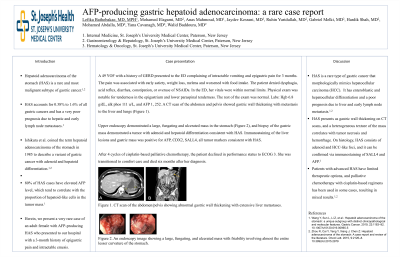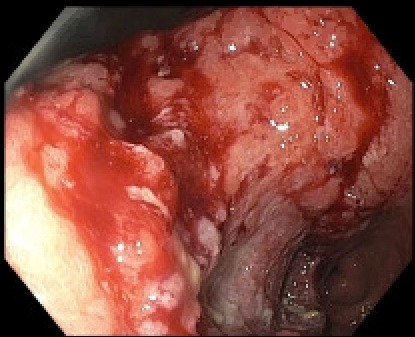Monday Poster Session
Category: Stomach
P2778 - AFP-Producing Gastric Hepatoid Adenocarcinoma: A Case Report and Literature Review
Monday, October 23, 2023
10:30 AM - 4:15 PM PT
Location: Exhibit Hall

Has Audio

Lefika Bathobakae, MD, MPH
St. Joseph's University Medical Center
Paterson, NJ
Presenting Author(s)
Lefika Bathobakae, MD, MPH, Mohamed Elagami, MD, Anas Mahmoud, MD, Jaydev Kesrani, MD, Ruhin Yuridullah, MD, Gabriel Melki, MD, Hardikkumar Shah, MD, MPH, Mohamed Abdalla, MD, Walid Baddoura, MD
St. Joseph's University Medical Center, Paterson, NJ
Introduction: Hepatoid adenocarcinoma of the stomach (HAS) is a rare and most malignant subtype of gastric cancer. Herein, we present a very rare case of AFP-producing gastric hepatoid adenocarcinoma in a patient with a 3-month history of epigastric pain and intractable vomiting.
Case Description/Methods: A 49-year-old female with a history of GERD presented to the ED complaining of intractable vomiting and epigastric pain for 3 months. The pain was associated with early satiety, weight loss, melena and worsened with food intake. The patient denied dysphagia, acid reflux, diarrhea, constipation, or overuse of NSAIDs. In the ED, her vitals were within normal limits. Physical exam was notable for tenderness in the epigastrium and lower paraspinal tenderness. The rest of the exam was normal. Labs: Hgb 6.8 g/dL, alk phos 111 u/L, and AFP 1, 252. A CT scan of the abdomen and pelvis showed gastric wall thickening with metastasis to the liver and lungs. Upper endoscopy demonstrated a large, fungating and ulcerated mass in the stomach, and biopsy of the gastric mass demonstrated a tumor with adenoid and hepatoid differentiation consistent with HAS. Immunostaining of the liver lesions and gastric mass was positive for AFP, CDX2, SALL4, all tumor markers consistent with HAS. After 4 cycles of palliative chemotherapy consisting of cisplatin 75 mg/m2 on day 1 + etoposide 100 mg/m2 on day 1-3, the patient declined in performance status to ECOG 3. She was transitioned to comfort care and died six months after her diagnosis.
Discussion: HAS is a rare type of gastric cancer that morphologically mimics hepatocellular carcinoma (HCC). It has enteroblastic and hepatocellular differentiation and a poor prognosis due to liver and early lymph node metastasis. HAS presents as gastric wall thickening on CT scans, and a heterogeneous texture of the mass correlates with tumor necrosis and hemorrhage. On histology, HAS consists of adenoid and HCC-like foci, and it can be confirmed via immunostaining of SALL4 and AFP. In early-stage cancers, surgery is the primary treatment with curative intent, but the role of neoadjuvant and adjuvant chemotherapy is unclear. Almost all evidence is retrospective in the form of case reports, and there are no clear NCCN guidelines for the treatment of this pathology. Patients with advanced HAS have limited therapeutic options, and palliative chemotherapy with cisplatin-based regimens has been used in some cases, resulting in mixed results.

Disclosures:
Lefika Bathobakae, MD, MPH, Mohamed Elagami, MD, Anas Mahmoud, MD, Jaydev Kesrani, MD, Ruhin Yuridullah, MD, Gabriel Melki, MD, Hardikkumar Shah, MD, MPH, Mohamed Abdalla, MD, Walid Baddoura, MD. P2778 - AFP-Producing Gastric Hepatoid Adenocarcinoma: A Case Report and Literature Review, ACG 2023 Annual Scientific Meeting Abstracts. Vancouver, BC, Canada: American College of Gastroenterology.
St. Joseph's University Medical Center, Paterson, NJ
Introduction: Hepatoid adenocarcinoma of the stomach (HAS) is a rare and most malignant subtype of gastric cancer. Herein, we present a very rare case of AFP-producing gastric hepatoid adenocarcinoma in a patient with a 3-month history of epigastric pain and intractable vomiting.
Case Description/Methods: A 49-year-old female with a history of GERD presented to the ED complaining of intractable vomiting and epigastric pain for 3 months. The pain was associated with early satiety, weight loss, melena and worsened with food intake. The patient denied dysphagia, acid reflux, diarrhea, constipation, or overuse of NSAIDs. In the ED, her vitals were within normal limits. Physical exam was notable for tenderness in the epigastrium and lower paraspinal tenderness. The rest of the exam was normal. Labs: Hgb 6.8 g/dL, alk phos 111 u/L, and AFP 1, 252. A CT scan of the abdomen and pelvis showed gastric wall thickening with metastasis to the liver and lungs. Upper endoscopy demonstrated a large, fungating and ulcerated mass in the stomach, and biopsy of the gastric mass demonstrated a tumor with adenoid and hepatoid differentiation consistent with HAS. Immunostaining of the liver lesions and gastric mass was positive for AFP, CDX2, SALL4, all tumor markers consistent with HAS. After 4 cycles of palliative chemotherapy consisting of cisplatin 75 mg/m2 on day 1 + etoposide 100 mg/m2 on day 1-3, the patient declined in performance status to ECOG 3. She was transitioned to comfort care and died six months after her diagnosis.
Discussion: HAS is a rare type of gastric cancer that morphologically mimics hepatocellular carcinoma (HCC). It has enteroblastic and hepatocellular differentiation and a poor prognosis due to liver and early lymph node metastasis. HAS presents as gastric wall thickening on CT scans, and a heterogeneous texture of the mass correlates with tumor necrosis and hemorrhage. On histology, HAS consists of adenoid and HCC-like foci, and it can be confirmed via immunostaining of SALL4 and AFP. In early-stage cancers, surgery is the primary treatment with curative intent, but the role of neoadjuvant and adjuvant chemotherapy is unclear. Almost all evidence is retrospective in the form of case reports, and there are no clear NCCN guidelines for the treatment of this pathology. Patients with advanced HAS have limited therapeutic options, and palliative chemotherapy with cisplatin-based regimens has been used in some cases, resulting in mixed results.

Figure: Figure 1.0: An endoscopy image showing a large, fungating, and ulcerated mass with friability involving almost the entire lesser curvature of the stomach.
Disclosures:
Lefika Bathobakae indicated no relevant financial relationships.
Mohamed Elagami indicated no relevant financial relationships.
Anas Mahmoud indicated no relevant financial relationships.
Jaydev Kesrani indicated no relevant financial relationships.
Ruhin Yuridullah indicated no relevant financial relationships.
Gabriel Melki indicated no relevant financial relationships.
Hardikkumar Shah indicated no relevant financial relationships.
Mohamed Abdalla indicated no relevant financial relationships.
Walid Baddoura indicated no relevant financial relationships.
Lefika Bathobakae, MD, MPH, Mohamed Elagami, MD, Anas Mahmoud, MD, Jaydev Kesrani, MD, Ruhin Yuridullah, MD, Gabriel Melki, MD, Hardikkumar Shah, MD, MPH, Mohamed Abdalla, MD, Walid Baddoura, MD. P2778 - AFP-Producing Gastric Hepatoid Adenocarcinoma: A Case Report and Literature Review, ACG 2023 Annual Scientific Meeting Abstracts. Vancouver, BC, Canada: American College of Gastroenterology.
